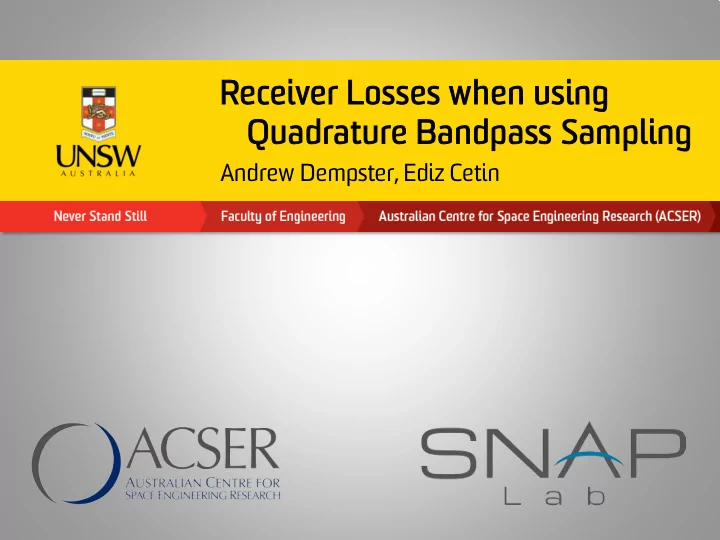

Receiver L Losses w when using Quadr drature Ban Bandpas ass Samplin ling Andrew Dempster, Ediz Cetin
How Bandpass Sampling Works • exploits aliasing • brings all images with it – must attenuate out of band “ images ” received signal sampling frequency IGNSS 2016, UNSW, Sydney 2
Bandpass Sampling: GPS L1 • For GPS L1 signal, with carrier 1.6 GHz, BW 2MHz: – Lowpass sampling would require sampling rates of 3.2Gs/s – Bandpass sampling requires a minimum rate of twice the BW, i.e. 4Ms/s IGNSS 2016, UNSW, Sydney 3
Bandpass Filter Design • For Bandpass sampling: N p in-band noise S = N 0 out-of-band noise SNR + − s N ( n 1 ) N n subsampling ratio p 0 • Max subsampling ratio for GNSS is for L1 GPS: f = = = max n 1576/2 788 max B • Requires N p /N 0 of 29dB for 3dB SNR loss IGNSS 2016, UNSW, Sydney 4
Bandpass Sampling • Sampling rate must be at least twice the signal bandwidth (Nyquist) • It must also, because a virtual downconversion results, ensure each downconverted band does not: – overlap dc, – overlap the Nyquist rate, or – overlap any other downconverted signal band IGNSS 2016, UNSW, Sydney 5
2B is not to be • Need more than twice the bandwidth sometimes: Vaughan, R.G.; Scott, N.L.; White, D.R.; “ The theory of bandpass sampling”, IEEE Trans Signal Processing, Volume 39, Issue 9, Sept. 1991 Page(s):1973 - 1984 IGNSS 2016, UNSW, Sydney 6
Sampling at 2B f s B IGNSS 2016, UNSW, Sydney 7
Sampling at the Minimum Rate IGNSS 2016, UNSW, Sydney 8
Exceeding the Minimum is not enough either Vaughan, R.G.; Scott, N.L.; White, D.R.; “ The theory of bandpass sampling”, IEEE Trans Signal Processing, Volume 39, Issue 9, Sept. 1991 Page(s):1973 - 1984 Slide 9 IGNSS 2016, UNSW, Sydney 9
Exceeding the Minimum is not enough either 2 • fu=2.5B, 1.5 fs=3.5B 1 0.5 0 -0.5 -1 -1 0 1 2 3 4 5 6 multiples of bandwidth B IGNSS 2016, UNSW, Sydney 10
“Normal” Quadrature Sampling • RF signal split into I/ Q by 90° phase shift in downconversion ~ ~ i o (n) X ~ ADC s ( t ) 0° ω LO T s 90° ~ ~ X q o (n) ~ ADC IGNSS 2016, UNSW, Sydney 11
Quadrature Bandpass Sampling • I/ Q from delay in sampling: ∆ t = 1/4f c i 1 (n) ADC s ( t ) ~ ~ 0 ~ T s ∆ t q 1 (n) ADC IGNSS 2016, UNSW, Sydney 12
Quadrature Bandpass Sampling • Sampling rate must be at least twice the signal bandwidth (Nyquist) • Overlaps are allowed: – overlap dc, – overlap the Nyquist rate – overlap any other downconverted signal band • BPS: no band overlaps • QBPS: 2 bands can overlap but not 3 IGNSS 2016, UNSW, Sydney 13
Dempster, Andrew G. , “Quadrature Bandpass Sampling Rules for Single- and Multiband Communications and Satellite Navigation Receivers”, IEEE Transactions on Aerospace and Electronic Systems, vol 47, no 4, Oct 2011, pp 2308 – 2316 IGNSS 2016, UNSW, Sydney 14
BPS vs QBPS rates “ channel ” rate “ total ” rate Dempster, Andrew G. , “Quadrature Bandpass Sampling Rules for Single- and Multiband Communications and Satellite Navigation Receivers”, IEEE Transactions on Aerospace and Electronic Systems, vol 47, no 4, Oct 2011, pp 2308 – 2316 IGNSS 2016, UNSW, Sydney 15
Distortion due to QBPS vs Sampled Quadrature Downconversion • Signal • Sampled I/Q distortion • QBPS A.G. Dempster , E. Cetin, “QBPS in RF front-ends”, Electronics Letters, vol 52 no 23, 3 Nov 2016, pp1965 - 1967 IGNSS 2016, UNSW, Sydney 16
Simple Remedy i o (n), q o (n) Baseband or IF Processing I/Q s ( t ) i 1 (n) i’ 1 (n) ∆ t QBPS q 1 (n) Naïve reconstruction Simple Remedy IGNSS 2016, UNSW, Sydney 17
Image Rejection Ratio • For – x(t) = e j ω t input – y(t) = α e j ω t + β e -j ω t output • IRR = 20 log 10 ( β/α ) IGNSS 2016, UNSW, Sydney 18
IRR for corrected, uncorrected • Naïve single frequency • Naïve band • Simple remedy A.G. Dempster , E. Cetin, “QBPS in RF front-ends”, Electronics Letters, vol 52 no 23, 3 Nov 2016, pp1965 - 1967 IGNSS 2016, UNSW, Sydney 19
IRR: Naive IGNSS 2016, UNSW, Sydney 20
IRR: Band • GPS L1 IGNSS 2016, UNSW, Sydney 21
IRR: Band • Galileo E5 IGNSS 2016, UNSW, Sydney 22
IRR: remedy • GPS L1 IGNSS 2016, UNSW, Sydney 23
Achievable IRR IGNSS 2016, UNSW, Sydney 24
Conclusions • QBPS can readily be used without remedy and achieve good IRR • Remedy improves at some frequencies IGNSS 2016, UNSW, Sydney 25
Recommend
More recommend